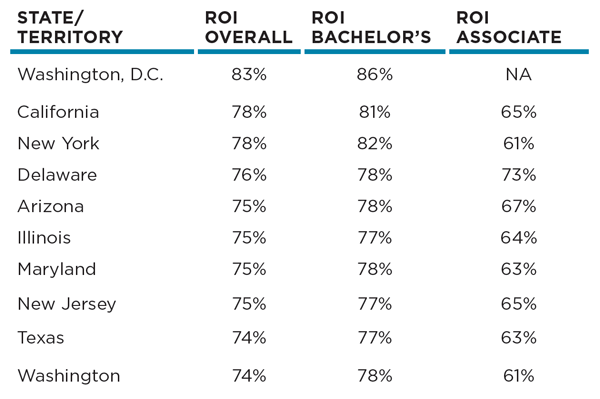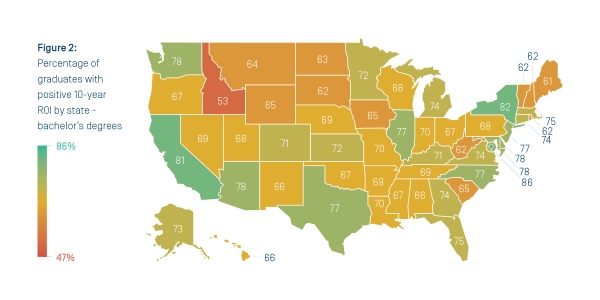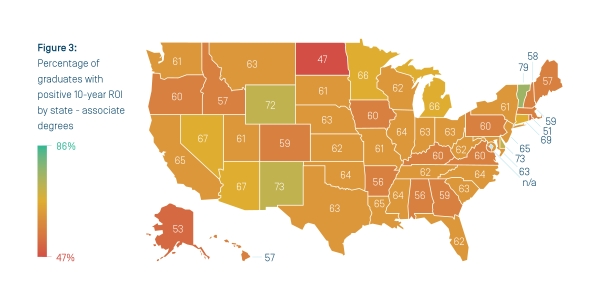It can be difficult to align post-secondary education goals with the goals of employers who — despite the growing array of certificates, degrees and other credentials — are still having a hard time filling high-skill, high-wage roles. For students who may have affordability and other challenges, the question is even more direct: Is it worth it for me to even pursue post-secondary education?
If only there were a scorecard that helped both sides.
Such a tool made its debut in April 2024 when Strada Education Foundation published the State Opportunity Index, which “establishes a baseline for how states are doing in five priority areas: Clear Outcomes, Quality Coaching, Affordability, Work-Based Learning, and Employer Alignment,” said the Foundation. “Taken together, these five priorities provide a research-driven framework for improving the policies and practices to support educators, students and employers.”
The Strada report’s findings were among several factors that comprised the 2025 Regional Workforce Development Rankings published by Site Selection magazine in its January 2025 issue. Other criteria included state-level incentives for work-based learning; the state’s performance in CNBC’s America’s Top States for Business 2024 Workforce and Education sub-ranking; the state’s performance in U.S. News & World Report’s 2024 Best States for Education ranking; and the state’s number of ACT National Career Readiness Certificates for 2024.
California and Washington — singled out by Strada for the relative affordability of education after high school — finished No. 1 and No. 2, respectively, in Site Selection’s rankings in 2024 and 2025.
The Index categorizes state progress in each of the five areas as Leading, Advanced, Developing or Foundational. In addition to the five priority areas, the Index also includes a return on investment (ROI) calculation for each state that employers will find as compelling as state policymakers do. “ROI is determined by calculating the percentage of the graduates who would likely experience a positive return on their investment based on the income distribution for recent college graduates in the state,” the report explains. “A positive ROI value indicates that graduates in that state earn wages higher than the wages earned by those who do not have an education beyond high school, and that the earnings premium they experience over a 10-year period is greater than their total investment in education after high school.”

The metric was calculated using the College Scorecard institutional dataset (accessed fall 2023) and earnings data from the American Community Survey (ACS) from 2017 through 2021. And there is a caveat directly related to physical location and mobility: “It is important to note that by analyzing earnings for degree holders in a state the estimate does not precisely analyze the earnings of graduates who completed their degree from a public institution in that particular state, since graduates may move between states,” the report states. “This is likely more influential for small states such as Rhode Island, Delaware or Washington, D.C., than for large states such as Texas or California. However, the advantage to using the individual earnings data from the ACS is that they allow us to look at the full distribution of outcomes for degree holders rather than simply median earnings. The estimate can therefore most closely be characterized as the likelihood of achieving positive ROI if a graduate were to remain in state.”
Among the findings to emerge from the ROI calculations is this compelling tidbit: The likelihood of positive ROI for bachelor’s degree and associate degree graduates differed markedly by race. Chinese students were at a median 84% across all levels of cost and Black students at 70% for bachelor’s degrees. For associate degrees, Chinese students averaged out to around 70% while white students were at 60% and Black students were at 57%.
Here are the top 10 states (including non-state No. 1 D.C.) for overall ROI:
Notably, only one of these states — Delaware — has an associate degree ROI over 70% at 73%, a level matched by New Mexico. The highest in the nation for associate degree ROI (and the only other state at 70% or above) is Vermont at 79%.
In total, 19 states demonstrate overall ROI of 70% or above, including Connecticut, Massachusetts and North Carolina at 73%, just missing out on the top 10.
The Five Priority Areas
Here we break down the report’s findings across its chosen five areas of focus:
Clear Outcomes: One thing Strada takes care to examine is the quality of education-to-employment data systems. Only a few states qualify as “leading” in that “clear outcomes” category: Arkansas, Colorado, Connecticut, Georgia, Kentucky, Maryland, Minnesota, Rhode Island, and Virginia.
Quality Coaching: The report does not break out states in its quality coaching metric, but does state that only about one-quarter of graduates from two-year institutions and one-fifth of graduates from four-year institutions “experienced personalized coaching that included key information and support.” In other words, no states have yet emerged out of the “foundational” level to merit the labels of developing, advanced or leading.
Affordability: “Based on this measure, California and Washington are the most affordable states to attend college,” the report said of the only two states to attain “leader” status in this category. “A student paying the average net price in these states would be able to cover the costs of tuition, fees and living expenses by working fewer than 10 hours per week during the school year and full time during the summer.”
It is in the final two categories — work-based learning and employer alignment — where employers can exercise more influence through implementing more internships, apprenticeships and curriculum partnerships.
Employer Alignment: “We envision a future in which students can readily access programs that lead to quality jobs and mobility, and employers assess and advance individuals based on skills and experiences, not just degrees,” said the report. Elsewhere the report notes, “Restriction on access to high-demand programs — and a lack of will to remove them — are a signal that education after high school is not fully aligned with opportunities in the labor market. Institutions may limit the number of students accepted into these programs because of insufficient funding for faculty and other resources needed, but these kinds of restrictions have a disproportionate impact on the students that would benefit most from these programs.”
No states meet overall employer alignment criteria for Leading. However, 13 states are advanced, led by Rhode Island and Utah, and 28 states are Developing. Top states for meeting the demand for talent in opportunity jobs include Alabama, Rhode Island, Utah, and West Virginia. Meanwhile, top states for college-level employment are Maryland, Massachusetts, Utah and Washington, D.C.

Work-Based Learning: Only around 25% of students at four-year institutions and 10% of students at two-year institutions participate in a paid internship, despite the evidence showing how well they work for all parties. “Graduates who completed a paid internship are much more likely to have a first job that requires their degree (73%) compared to those who did not complete an internship (44%),” the report states. “They are also more likely to be satisfied with their first job and with the progress they are making toward their long-term career goals compared to students who had an unpaid internship or no internship at all.”
One Million Degrees Happen One Degree at a Time
In a September 2024 interview session with officials from the One Million Degrees (OMD) program at Harold Washington College, part of the City Colleges of Chicago system, I heard paid internship program leaders at Aon and Allstate endorse the absolute merits of such programs in one of the Strada report’s top ROI states.
“One Million Degrees accelerates community college students’ progress on career pathways to economic mobility,” said Samantha Kyrkostas Mills, executive director of development for the program that offers stipends for students entering community college and serves 2,400 students in Chicagoland. “We have two north stars: completion and a good job,” she said. “I often hear, ‘I came to One Million Degrees because of the money but I stayed because of the community.’ ”
A randomized controlled trial with the University of Chicago Inclusive Economy Lab showed that OMD students were 94% more likely to persist from fall to spring semesters and 73% more likely to earn a degree. Moreover, there was a $42 million aggregate annual increase in lifetime earnings per 1,000 students and a $3,000-per-student economic return for City Colleges through increased tuition.

“We were one of the original employer partners who invested and wanted community college students as a pipeline,” said Ben Scherr, senior career advancement coordinator for Allstate’s program that includes tracks in insurance, HR and IT and supports sites in Chicago and suburban Lincolnshire as well as other sites in the country. “There are no degree requirements. It is a two-year program. After that, they are guaranteed a position at Aon, which is huge. They are also not required to go on to their 4-year degree to move up in the organization. Compensation is reevaluated every six months.”
The program started with 25 apprentices and now has 60, part of 147 apprentices that have moved through multiple OMD cohorts at both companies. The Allstate program’s 2022 cohort overshot OMD’s goal of 80% degree completion by achieving 100% instead.
Aon’s program also is national in scope, said Jazmine Santos, the company’s senior career advancement coordinator. “OMD is supporting students across the nation,” she said. Like Allstate’s, the program is for up to 24 months. “If they complete their degree earlier,” she said, “then they are eligible to move into their full-time position.”
What’s it pay? At Aon, explained Erika Ehmann, director of workforce programs at One Million Degrees, apprentices start off as salaried employees or hourly, and are also eligible for benefits. “Some start at $42,000 a year. One they graduate, they will go from a level 8 role and can be eligible for level 7, and that can increase their salary by upwards of $20,000 to $40,000. This is the gold standard. We are requiring partners to enter in a partnership and pay our scholars a living wage the MIT calculator says will be $24.50 for our scholars. And it will go up. There is an employer rubric we use, and that is non-negotiable with our partners.”
As for day-to-day work, Scherr said there are three key strategies for monitoring and supporting apprentices.
“The first one happens during orientation for the first six weeks — cultural humility. I’m curious about who you are and understanding your ‘why’ right away. There is the campus to corporate transfer, realizing you’re not being graded on everything you do — anti-excellence, pro-participation. And just like OMD, I encourage the apprentices to create their own personal board of directors and advisors. Those three things really build on the success.”
So do more fundamental things related to daily struggles and an opportunity to put corporate values into action.
“The beliefs and values of Allstate and OMD are similar,” said Scherr, observing how grants “really help keep our apprentices in school and in their jobs, from starting out in their first couple weeks, having car or child care issues, living in hotels, choosing groceries over 3-credit classes. They don’t have to make that decision any more. If we can’t provide the resource ourselves, we’re working with our different partners to make sure they know about it, so those barriers aren’t barriers.”
Asked what skills they’d observed to be most critical for apprentices to develop, Aon’s Jazmine Santos said enthusiasm and a growth mindset.
“A lot of managers want apprentices to be excited, even if insurance isn’t the sexiest thing to be excited about,” she said. “So, showing up with enthusiasm, being ready to learn and curious. Who is excited to learn about the company and get involved? Those are the ones who get called into special events or to share their experience.”
A growth mindset, meanwhile, is important for going through life in general, she said, and meaningful to any of her apprentices whether they are 18 years old or in their 50s. “A lot want to be perfect, and when they fail, it’s hard to get out of that mood,” she said. “Fail fast. Give yourself grace. It’s transferable as they go through life. I tell them, ‘You are going to fail. That’s going to be OK. What matters is we reflect and move forward from there.’ ”
The ultimate takeaway? “This works,” said Scherr. “One Million Degrees works. We’ve had a 75% conversion rate for roles that typically went for bachelor’s degree or above. Ask those apprentices and they’d say they would never have had their resumes looked at … pay-wise, it’s a different tax bracket. So the economic mobility and pathway is there for sure.”

